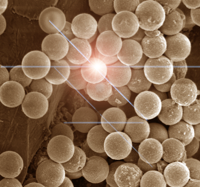Dr. med. Carolin M. Langer

Cellular therapies require methods for noninvasive visualization of transplanted cells. Micron-sized iron oxide particles (MPIOs) generate a strong contrast in magnetic resonance imaging (MRI) and are therefore ideally suited as an intracellular contrast agent to image cells under clinical conditions. However, MPIOs were previously not applicable for clinical use. her thesis focussed on the development and evaluation of silica-based micron-sized iron oxide particles (sMPIOs) with a functionalizable particle surface. Labeling was stable and had no adverse effects on labeled cells. Silica is a biocompatible material that has been approved for clinical use. sMPIOs could therefore be suitable for future clinical applications in cellular MRI, especially in settings that require strong cellular contrast. Moreover, the particle surface provides the opportunity to create multifunctional particles for targeted delivery and diagnostics.
Congratulations !

